The Complete Guide to Understanding Coaxial Cables

Coaxial Cable: Understanding the Basics
Coaxial cables are widely used in today’s technology-driven world to transmit high-frequency signals with minimal loss. These are electrical transmission lines that possess a unique design that enables them to transmit signals over long distances. They typically consist of an inner conductor, insulation, a metallic shield, and an outer jacket that provides additional protection against physical damage and interference.
Appearance of a Coaxial Cable: A Visual Description

Before we get into how coax cables work, you need to know how they’re constructed.
As you can see from the above image, there are four main parts to a coax cable:
1.Center Conductor/Core
2.Dielectric Insulator
3.Shield(s)
4.Jacket (Rubber Wrapper)
At the core, coaxial cables consist of a single copper or copper-coated steel wire. It’s what carries the RF signals. A dielectric insulator, often made of plastic, surrounds the wire. It keeps a constant distance between the center conductor and the next layer.
The metal shield, made of woven copper, aluminum, or other metals, wraps around the insulator. It cancels outside electromagnetic interference. Some coaxial cables are constructed with multiple shields for extra protection. The final layer is a jacket that protects the whole configuration. Its rating (more on this later) lets you know where the cable can be installed.
Outdoor-rated cables need extra insulation and special jackets to protect the wires from sun and moisture.
Coaxial Cables: Understanding Their Functionality
Coaxial cables are an essential component in transmitting signals through a wired connection. The signal is carried through the center wire of the cable, but for optimal performance and to prevent bleeding, a metal shield is necessary. The current passing through both components simultaneously generates a magnetic field that preserves the signal quality.
One significant advantage of coaxial cables is their ability to resist electromagnetic interference. The metal shield provides protection from external sources, allowing them to be placed near other electronic devices without interruption. The dielectric insulator plays a crucial role in maintaining the consistency of the distance between the core and shield, preventing contact and signal cancellation.
The outer jacket protects all components from external damage, ensuring longevity and durability. Through this technology, RF signals can be transmitted over long distances with minimal interference or loss, making them ideal for various applications. Upon receiving the signal, it can be converted into different formats such as images, audio, WiFi, or amplified cell reception, depending on its designated function.
Overall, coaxial cables offer reliable and efficient signal transmission through a wired connection. With the right components and insulation, they prove to be a valuable asset in modern technology and communication.”
What are the Uses and Applications of Coaxial Cables

Coaxial cable is used by cable operators, telephone companies, and internet providers. They’re necessary for applications requiring radio frequency transmissions, such as:
Cable TV
If you have cable television, coaxial cable is used to carry video and data from the cable company to your TV. They’re also used to connect your television or digital converter box to a personal antenna.
Signal Boosters
Wilson Amplifiers is the leading provider of cell phone boosters. These devices use an outdoor antenna, an amplifier, and an indoor antenna. Coaxial cables are used to connect the three components. It also bypasses signal blocking material. We have a full guide on how a signal booster works for more information.
With this technology, you can boost your weak outside cell signal and enjoy stronger signal inside your home, office, or vehicle.
Cable Internet (Copper-Based)
Cable internet uses coax cable to provide your home with internet. The copper-based cable is piped into your house from the cable service provider. Your router or cable modem connects to a coax or ethernet outlet to receive the signal. You can then wire your devices to the router or connect via WiFi for speedy internet access.
Ham Radio
Ham radio is a means for people to communicate over airwaves. Coaxial cable connected to the antenna provides a stronger signal. Ham radios can be set up in the middle of nowhere and do not require internet or cell phone technology.
Basic RF Systems
RF (Radio Frequency) waves are generated when an alternating current goes through a conductive material. Coax cables carry radio frequency signals. They can be used with any RF system.
Are All Coax Cables the Same?
While all coaxial cables are used to transmit signals, they are not all the same. Coaxial cables vary in size, material, and shielding. Each type of coax cable works best with specific applications.
Coaxal Cable Types
There are many different types of cables to choose from. They fall within two categories, RG and LMR type. Your application will determine which one has the best characteristics. Here are the most common coax cable types:
RG Coax Cables
RG, short for Radio Guide, is the original military specification for coaxial cables. The RG number refers to the cable’s diameter. However, measurements do vary. Generally, a higher RG numbers means a thinner central conductor, and vice versa.
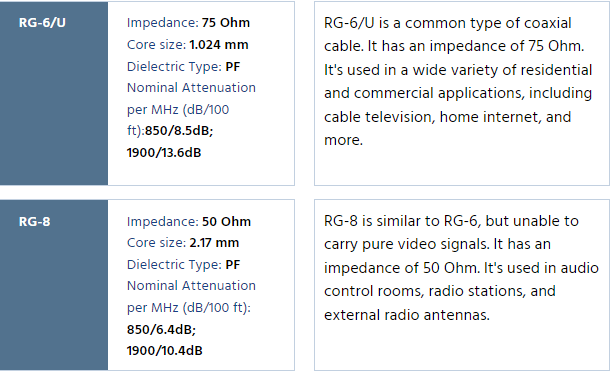

LMR® Coax Cable
LMR® is the newer generation of RF coaxial cables. They provide greater flexibility, ease of installation, and lower cost. They’re used as transmission lines for antennas on missiles, airplanes, satellites, and communications. The LMR ® number is a rough estimate of the cables thicknes.
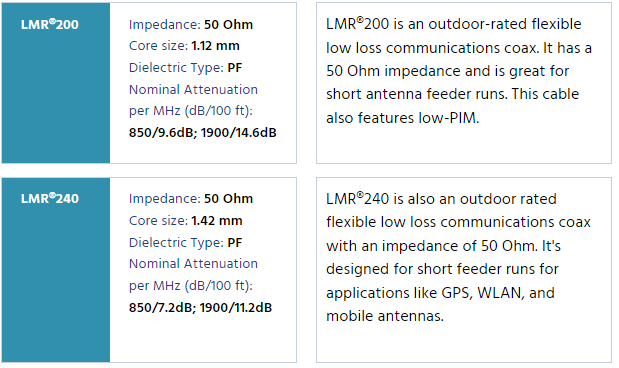
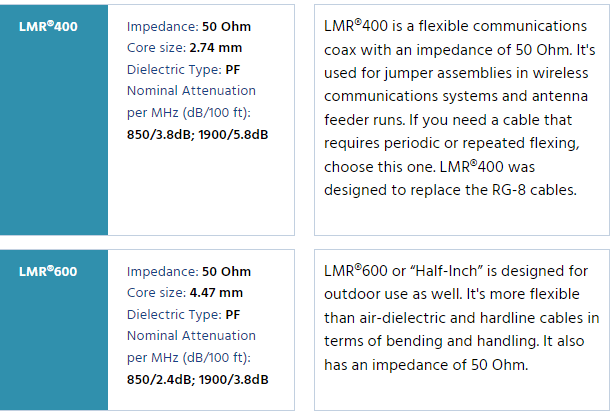

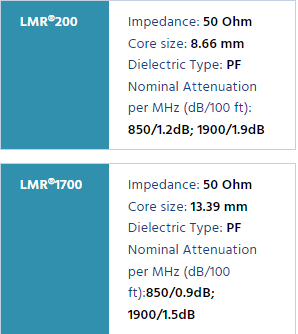
How to Identify Coaxial Cable Types?
The numbers and letters printed on the cable jacket tell you everything you need to know. The type of cable it is, who manufactured it, rating, and more.
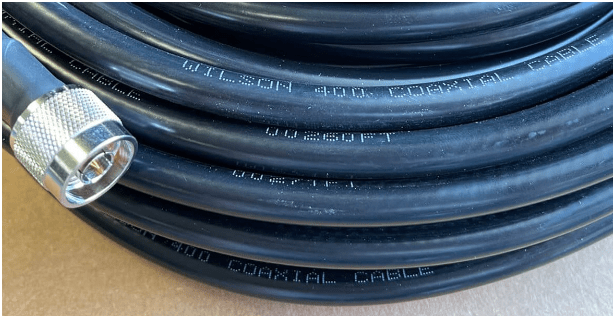
Coaxial Cable Signal Loss (Per 10 Feet)
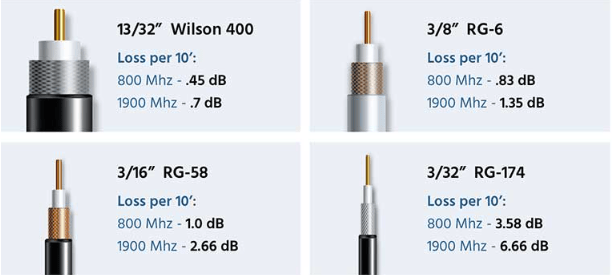
Signal loss happens with all types of coaxial cable. As signal travels through the cable, it loses energy. It’s inevitable. With increased cable length more signal loss occurs.
Signal gain and loss are measured in decibels (dB), which are measured exponentially. A loss of 3 dB means a weakened signal by 2x!
Per the image, the Wilson400 (and the equally powerful RG-11) has the least loss per 10ft. It’s almost twice as effective compared to the RG-6 for home installations. The only mightier cable is the pricey LG600 and even pricier Half-Inch.
The RG-174 should never be installed in any unit that needs more than 6 feet of cable. It does a poor job of carrying signal at 10 feet.
Signal loss doesn’t end there. Mixing and matching 50 Ohm and 75 Ohm cables and systems (more on this later) can lead to further signal loss. While you can customize your installation with connectors and adapters, it’s best to stay consistent.
To calculate the amount of loss you should expect, use an online calculator. For example, the QSL Loss Calculator. We don’t endorse this one specifically. Simply fill in the blanks and loss will be calculated in seconds.
There are many online calculators you can use as well as formulas for manual calculation.
Key Coaxial Cable Features to Evaluate Before Your Purchase

Coaxial Cable Length and Thickness
Coaxial cable comes in varying lengths and thicknesses. These features will determine the strength of the signal transmitted.
As mentioned, the longer the cable the more loss occurs when transmitting signal across long distances. Thick cable features lower loss than thin cable, making it ideal for long cable runs. For optimal transmission, you’ll want the shortest and thickest cable appropriate for your application.
In radio systems, cable length is comparable to the wavelength of the signals transmitted. You can study the math involved in deciding the best cable length to use. Characteristics of the cable, such as outside diameter of the inner conductor, inside diameter of the shield, dielectric contact of the insulator, and magnetic permeability of the insulator, all affect the quality of the wavelength going through your cable.
Coaxial Cable and dBm
dBm represents your signal strength. The type of coaxial cable used will determine how strong a signal your cable can handle. To learn the difference between dB and dBm, click here.
Coaxial Cable Impedance (Ohms)
Impedance is the amount of resistance waves moving through the coaxial cable encounters. The lower the impedance, the easier the waves flow through the cable. Each type of cable has an impedance rating. Factors affecting this are the size and materials of the cable.
Standard coax impedances are 50 and 75 Ohms. When tested, these impedance ratings were deemed a great balance between power handling and low loss.
What is the difference between 50 and 75 Ohm cables? This analogy might help. Think of signal as a drink and cables as straws. 75 Ohm cables are your typical soda straws, and 50 Ohm cables are jumbo straws.
While 50 Ohm cables transmit signal better, it doesn’t mean you need 50 Ohm cable.
50 Ohm cables tend to be better for high power handling applications. These could be commercial boosters, broadcasting TV transmitters, and ham radios. 75 Ohm cables are the popular choice for home and office applications. They’re used for residential signal booster installations, cable TV boxes, internet routers, and the like. These are general rules and do not apply to all types of cable.
When choosing cable, avoid mixing and matching 50 Ohm and 75 Ohm cables and systems. You should aim to use the same impedance throughout to prevent additional signal loss.
Coaxial Cable and PIM
PIM stands for Passive Intermodulation. When you connect two metals, the result is nonlinear elements, and distortion in the signal may occur.
As signal amplitude goes up, the effects will be more significant. This often happens when connecting antennas, cables, and connectors. PIM problems occur most often in cellular networks. To mitigate PIM issues, consider low-PIM cables, connectors, and adapters.
Coaxial Cable Rating
All coaxial cables are rated for different applications. The rating tells you everything you need to know about where the cable can be SAFELY installed. The most common are:
When it comes to choosing the right communication cable, there are various options available based on where the cable will be installed. Among the three common types of communication cables include Communications Multipurpose Plenum (CMP) Cable, Communications Multipurpose Riser (CMR) Cable, and Communications Multipurpose (CM) Cable.
CMP cables are designed to be used in plenum air spaces, which are areas specifically designed for air circulation. In such spaces, safety is of utmost concern, and this is where CMP cables come in handy. The jacket of CMP cables is made of fire-retardant and low smoke materials, which means it releases the lowest level of toxic fumes in the event of a fire. This makes it the safest choice for spaces designed for air circulation.
CMR cables, on the other hand, are suitable for running cables between floors through risers or vertical shafts. These cables are also designed with fire-retardant jackets to prevent fires from spreading between floors. Although not as heavy-duty as CMP cables, they are still a safe option in high-rise buildings.
For general-purpose applications, the CM cable or PVC cable is the most commonly used cable rating. They are rated for general-purpose applications such as connecting a computer to the wall, but they are not suitable for use in riser or plenum spaces. The jacket of CM cables is not as fire-retardant and will release toxic fumes. Therefore they should only be used in areas where safety is not a significant concern.
Overall, it is essential to understand the differences between these cable ratings to choose the right cable for your installation. Safety should always be the top priority when choosing communication cables, especially in areas with high human traffic, such as in public places or high-rise buildings.”
Coaxial Cable Connectors

At each end of a cable, you will find connectors which play an essential role in ensuring that the signal is maintained without any interruptions. These connectors are designed to guarantee that the cable’s integrity remains intact while transmitting signals. To enhance connectivity, connectors are typically coated with high-quality metals such as durable gold or silver that don’t tarnish easily.
To determine the type of connector you need for your connection, you should consider the device you are connecting to. Different devices require different types of connectors, and it’s crucial to select the appropriate connector to ensure optimal functionality. Therefore, it’s essential to understand the requirements of each device and select a connector that meets those needs.
To sum up, connectors play a critical role in maintaining the integrity of cables and ensuring smooth signal transmission. The type of connector that you need depends on the device you are connecting to, and it’s wise to understand these requirements before selecting the appropriate connector. Ultimately, using the right connector will enhance connectivity and ensure optimum performance.
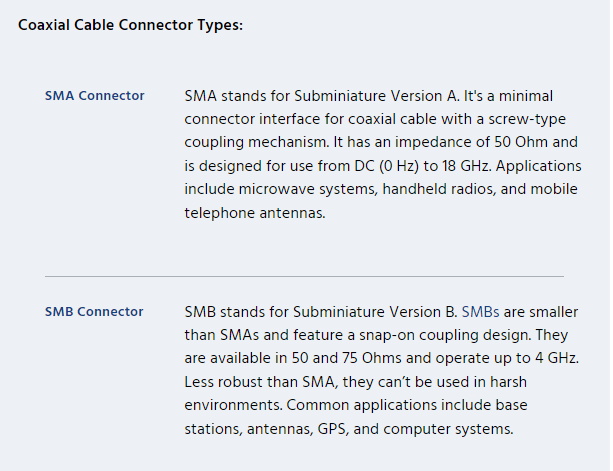
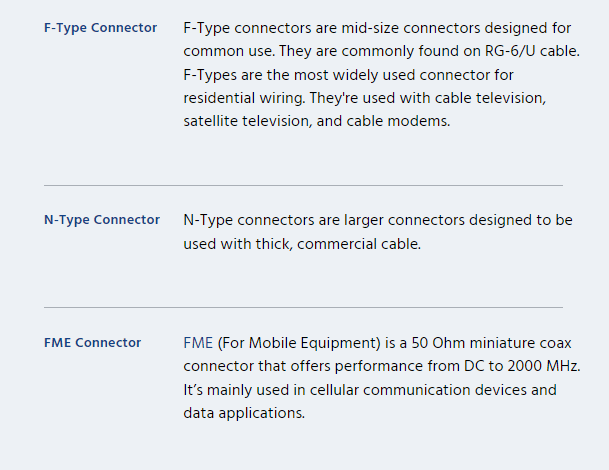

Male and female connectors come in two types: standard and reverse polarized. Standard polarized male connectors feature threads on the inside of the shell and a pin, while standard polarized female connectors have threads on the inside of the shell and no pin. Reverse polarized connectors switch the location of the hole and pin, so the female connector has the pin while the male connector has the hole.
Putting It Together
RG-6 Cables with F-Type Connectors

The RG-6 cable is a popular choice for cable and satellite TV connections, thanks to its 75 Ohm impedance with F-Type connectors. It is also commonly pre-installed in many homes, simplifying setup and installation for homeowners. The F-Type connector is a mid-size connector used widely for residential wiring.
This cable is generally used for average home installations ranging from 2,500 to 5,000 sq ft and cable lengths between 2 to 50 feet. The cable comes only in white. For those looking for a boosting solution for their home, the weBoost Home MultiRoom and the budget-friendly weBoost Home Room both feature the RG-6 cable as part of their kit. Overall, the RG-6 cable is an easy-to-use, reliable option for residential wiring needs.
RG-11 Cables with F-Type Connectors

The RG-11 cable is another 75 Ohm cable with F-Type connectors. What separates it from the RG-6 is its range. Whereas RG-6 tops out at 50 feet, RG-11 ranges from 2 feet to a 500-foot spool. It also features lower loss.
They are highly recommended if you need over 50 feet of cable to power your booster or any other RF system. RG-11 cable comes pre-kitted with the powerful weBoost Home Complete, weBoost Office 100 75 Ohm, and weBoost Office 200 75 Ohm.
LMR®400 Equivalent Cables with N-Type Connectors

Wilson400 cables are 50-ohm, pro-grade coaxial cables designed for large installations from 7,500 to 50,000 square feet. Cable length ranges from 2 to 1000 feet, spooled.
Your installer will typically apportion the cable into shorter lengths to cover the range of the installation while maintaining quality signal strength.
This Wilson400 is fitted with an N-Type connector, a large connector designed to be used with thick, commercial cable.
If you need to run cable through plenum airspaces, Wilson400 Plenum cable is available. It features ultra-low-loss and comes in a 500-foot spool with no connectors. Cable can be easily terminated to fit any application.
The most popular units that Wilson400 cables are the weBoost for Business and WilsonPro line of commercial signal boosters. However, they are compatible with any equipment that uses 50 Ohm cables fitted with N-Connectors. No unit includes Wilson 400 Plenum.
LMR®600 Equivalent and LDF4/AI4 RPV-50 “Half Inch” with N-Type Connector

For running cable beyond 150 feet, an installer might suggest using either an LMR®600 or a “half inch” coaxial cable. These cables are thicker and more durable than other options, and while more expensive, they are necessary for certain specialized situations. These two types of cables are the best available for maintaining high-quality signal strength on the market.
When it comes to the LDF4 and AI4 RPV-50 cables, the main difference lies in their interior construction. The LDF4 contains a foam covering, while the AI4 RPV-50 has no covering. However, these differences do not greatly affect their overall function. It’s important for installers to select the appropriate cable based on the specific needs of the project, as certain situations require different materials to ensure optimal performance. Ultimately, these specialized, industrial-grade coaxial cables are necessary in certain circumstances, and professionals should be consulted to determine which option is best.
RG-58 and RG-174 Cables with SMA Connectors

RG58 and RG174 cables are used in vehicle boosters. The difference between the two is the better low-loss quality of the RG58 with cable length up to 20 feet compared to the RG174’s 6 feet. For large vehicles, such as RVs or boats, the RG174 is preferred.
Both are fitted with SMA connectors. These are small, copper connectors used in modems and the like. They are relatively inexpensive, which allow for the cable’s cheaper cost.
Compatible with weBoost Drive Reach, weBoost Drive Sleek, and the weBoost Drive X.
Coaxial Cable Advantages and Disadvantages
Like all electrical equipment, coaxial cable has its advantages and disadvantages.
Advantages:
Durable
Good electromagnetic interference resistance
Affordable
Easy to customize and expand
Easy to wire and install
Disadvantages:
It can be bulky and an eyesore if not hidden
Expensive to professionally install for long runs
Cable failure can cause your entire network to go down
Fragile
Choosing Coaxial Cable: A Guide to Making the Right Decision

When choosing the best coax cable for your application, it’s essential to take different factors into account. Firstly, you should consider the device you’re using and the type of cable it requires. For example, a satellite dish may need a different cable than a cell booster. You should also consider whether the cable will be installed indoors or outdoors, as this can affect the cable rating needed.
To choose the best coax cable, it’s crucial to reference different cable types to determine which one will work best with your device. Consider the impedance, rating, and connectors you need and find a cable that matches your requirements.
The distance between your transmitter and receiver is an essential factor to consider. For instance, if you’re connecting an outdoor antenna to a cable box or amplifier, you should calculate the distance between these devices. Keep in mind that shorter cable runs result in crisper signals, so you should opt for a cable that’s close to the distance you calculated. Avoid going excessively longer or shorter than the calculated distance.
Cable loss is unavoidable when transmitting signals over a distance. To minimize signal loss, you should choose a thicker cable over a thinner one and a shorter cable over a longer one. Acceptable loss varies depending on your devices and application. To minimize loss, make sure that the impedances of your cables and devices match.
Remember, if you want to calculate signal loss accurately, various online calculators can help. By considering these factors, you can choose the best coax cable for your application, ensuring that you receive clear signals and optimal device performance.
Coaxial Cable FAQ
Coaxial Cable Transmission Speed: What You Need to Know
The rate at which data can be transmitted through a coaxial cable varies depending on the cable type and the technology used to achieve the speed. This is largely determined by factors such as the internet service provider or cable company.
Coaxial cables can achieve an average speed of 10 Mbps to over 100 Mbps. This makes them a popular choice for high-speed internet connections, audio and video transmission, and networking devices.
The type of coaxial cable and the level of shielding used can also affect transmission speed, with higher-quality cables boasting better performance.
Modern coaxial cables are able to transmit data at much higher speeds than their predecessors, thanks to advancements in technology. These advancements include higher frequency ranges and improved data compression techniques.
In summary, coaxial cables offer a reliable, high-speed option for data transmission, with transmission speeds varying depending on the specifics of the cable and underlying technology. So, selecting the right type of cable and technology is crucial to ensuring optimal performance.
Does Coax Cable Go Bad?
Coaxial cable can last for many years, but it can go bad. The main culprits are:
Heat damage – When exposed to high temperatures for a prolonged amount of time, the plastic wrap can melt. Unprotected, the inner components will get damaged.
Physical damage – Bending coax cable or stepping on it can damage the inner components, affecting transmission.
Water damage – Water inside the cable can affect the electrical components. Depending on severity, it can degrade performance or render the cable useless.
Connector damage – If a connector comes loose, rusts, or breaks, the cable can’t efficiently transmit information from one source to another or at all.
Increasing the longevity of your coaxial cable starts with buying the right cable. From there, make sure to install it correctly, weatherproof the connectors, and avoid bending it.
Outdoor Installation of Coaxial Cable: Is it Possible?
When it comes to using coaxial cable for outdoor applications, there are certain considerations to keep in mind. Additional insulation is necessary to protect the wires from weather and other elements. This is particularly important for cables that run along the outside of a building to connect to an antenna or cable box. In order to ensure seamless transmissions, the cable must be adequately protected, whether it’s exposed to the sun or buried in the earth.
At our company, we offer outdoor-rated coaxial cables that are specifically designed for outdoor use. However, it’s important to note that these cables are not rated for direct burial. This means that they should not be buried directly under the ground. Instead, they should be protected with conduit or other appropriate materials. By taking these precautions, you can be sure that your outdoor coaxial cables will provide reliable and high-quality transmissions for years to come.
Coaxial Cable Selection: Does it Impact Performance?
It is important to ensure that you are using the right cable for your signal booster to achieve optimal performance. Different signal boosters may require different types of cables than those used by radio systems. This means that it is crucial to select the cable that is appropriate for your specific application.
Using an incorrect cable can lead to a reduction in the signal strength, which could ultimately defeat the purpose of the signal booster. It is, therefore, essential to evaluate your signal booster and determine the type of cable you need for it to function effectively.
In conclusion, to get the best results from your signal booster, it is imperative to use a cable that is tailored to meet the requirements of your particular system. This will ensure that the signals are transmitted effectively, and there is no interruption in your network connectivity.








